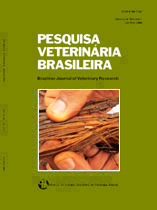 |
|
|
|
Year 2013 - Volume 33, Number 6
|

|
Acute fasciolosis in cattle in southern Brazil, 33(6):705-709
|
ABSTRACT.- Adrien M.L., Schild A.L., Marcolongo-Pereira C., Fiss.L., Ruas J.L., Grecco F.B. & Raffi M.B. 2013. Acute fasciolosis in cattle in southern Brazil. Pesquisa Veterinária Brasileira 33(6):705-709. Laboratório Regional de Diagnóstico, Faculdade de Veterinária, Universidade Federal de Pelotas, Campus Universitário s/n, Pelotas, RS 96010-900, Brazil. E-mail: alschild@terra.com.br
This study describes the epidemiological and pathological aspects of an outbreak of acute fasciolosis in cattle in southern Brazil. Fifteen out of 70 three-year-old pregnant cows lost weight in the 30-40 days prior to calving. Clinical signs included diarrhea, weakness, mild anemia and jaundice. Dark yellow fluid in the abdominal cavity was observed at necropsy. Fibrin and clotted blood were adhered to the pericardium and lung, primarily in the diaphragmatic lobes. The liver was enlarged, and the capsular surface was irregular with clear areas and petechiae. At the cut surface, the liver was irregular, firm and edematous, and several hemorrhagic channels could be observed. Areas of fibrosis through the parenchyma and whitish thrombi occluding the great vessels were also observed. The livers of 10 cows that not died were condemned at slaughter for lesions of fasciolosis similar to those observed at necropsy. Microscopically, the liver showed areas of coagulation necrosis, extensive hemorrhages in the streaks or foci and disruption of the parenchyma with neutrophil and eosinophil infiltration. Fibrosis and bile duct proliferation were also observed. Immature Fasciola hepatica flukes were observed in the parenchyma surrounded by degenerated hepatocytes, neutrophils, eosinophils, and hemorrhages. The outbreak occurred on a farm located in an area endemic for fasciolosis, although the acute form of the disease is not common in cattle in this region. It is likely that the cows were infected by F. hepatica metacercariae released in the late fall or early spring in the rice stubble where the herd was grazing prior to calving. Although mortality due to fasciolosis in cattle is infrequent, outbreaks can occur and treatments that are effective in both the immature and adult forms of the parasite should be administered to prevent economic losses. |
| |
|
|
| |
|
 |